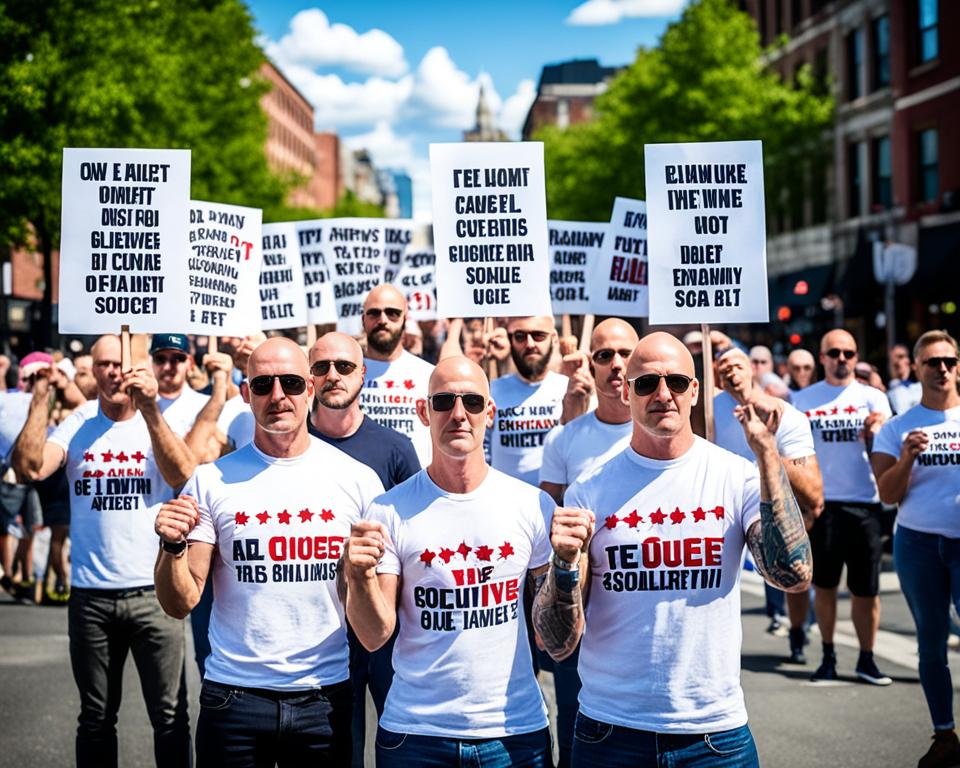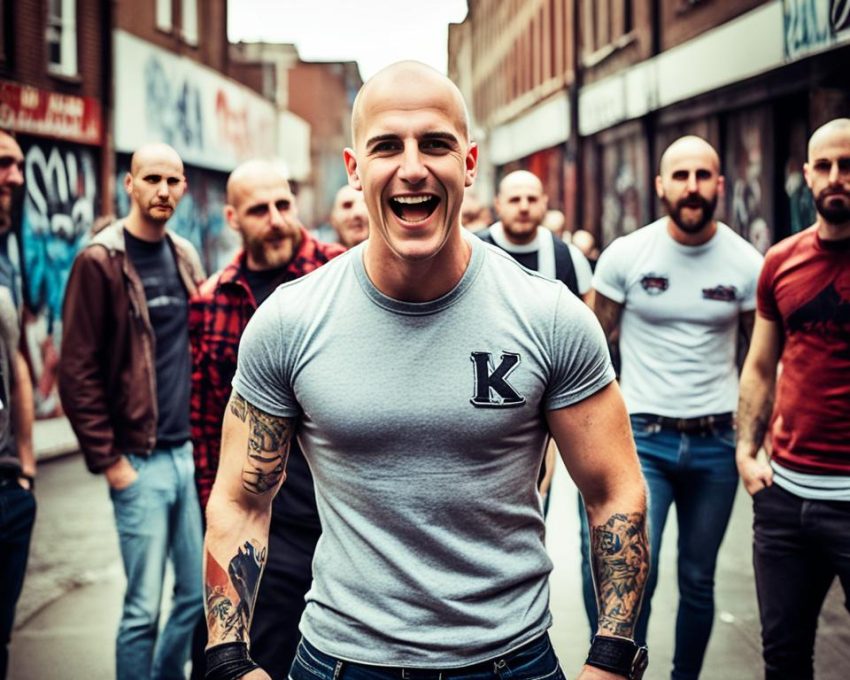Skinheads have always caught people’s eyes, but many don’t know the truth about them. This article will look into the Skinhead movement’s complex world. We’ll explore its beginnings, culture, and the different views on it. The Skinhead subculture has a deep history, often misunderstood.
Skinheads find their identity in belonging and rebelling against the norm. They stand out with their shaved heads, combat boots, and working-class style. But, their movement has faced issues with racism and neo-Nazism, making people see them differently.
This deep dive into the Skinhead subculture will show its many sides. We’ll follow its journey from the 1960s to now. We’ll clear up the wrong ideas and stereotypes about this movement, showing its true depth.
Read interesting things at : mbp-kagawa
Key Takeaways
- The Skinhead subculture has a rich and complex history, originating from working-class roots in the 1960s.
- The Skinhead aesthetic, including shaved heads and combat boots, has become a powerful symbol of identity and rebellion.
- The Skinhead movement has been heavily influenced by music genres like ska, reggae, and punk, contributing to its cultural significance.
- The rise of racist and neo-Nazi affiliations within the Skinhead subculture has led to widespread misconceptions and stereotypes.
- Understanding the diverse aspects of the Skinhead subculture is crucial in challenging these misconceptions and promoting a more balanced perspective.
The Skinhead Subculture: A Controversial Movement
The skinhead subculture has always been a topic of interest and debate. It started in the working-class areas of 1960s Britain. Over time, it has changed, drawing both praise and criticism from different groups.
At its core, the skinhead subculture mixes different cultural elements. It includes the sharp look of Savile Row suits and the lively sounds of ska and reggae music. Yet, it has also faced criticism due to racist and neo-Nazi groups. This has led to many wrong ideas and stereotypes about the skinheads.
“The skinhead subculture is a testament to the power of youth culture to shape societal narratives, for better or for worse.”
Despite the challenges, the skinhead subculture keeps growing and changing. It has moved from its working-class beginnings to now focus on anti-fascist and welcoming ideas. This change shows how the movement still grabs attention and sparks debate.
The skinhead subculture faces new challenges today. The debate about its role and effect is still important for experts in sociology, history, and culture.
Tracing the Origins of the Skinhead Movement
The skinhead subculture started in the 1960s in the UK’s working-class communities. It was shaped by the cultural and social changes of the time. It aimed to create a unique identity in a fast-changing society.
From Working-Class Roots to Cultural Phenomenon
Skinheads were known for their shaved heads, braces, and tough fashion. They were influenced by Jamaican ska and British mod music. This mix created a unique culture that quickly drew in young people.
As time went on, skinhead culture spread beyond the UK, becoming a worldwide phenomenon. It moved beyond its working-class roots, drawing people from all walks of life. The skinhead look and way of life became a way to show rebellion and find community in a changing world.
| Emergence of Skinhead Subculture | Influential Factors |
|---|---|
| 1960s, United Kingdom |
|
| Transformation to Global Cultural Phenomenon |
|
The skinhead movement grew from a UK working-class subculture to a global phenomenon. Its lasting impact on culture and society is still studied and admired today.
The Allure of the Skinhead Aesthetic
The skinhead look has always caught the eye of many. It’s known for its shaved heads, combat boots, and certain clothes. This style is a key part of the skinhead culture. But what makes this aesthetic so lasting and powerful?
The skinhead style is about more than just clothes. It’s a way to show who you are and stand out. The clean-shaven look and the choice of clothes are a way to reject the usual and show your unique identity. Over time, different groups within the skinhead movement have made their own styles.
“The skinhead aesthetic is a visual representation of the subculture’s values – a blend of working-class pride, anti-establishment sentiment, and a desire for a sense of belonging.”
The skinhead style has also changed popular culture. Its look, with shaved heads, braces, and bomber jackets, has influenced fashion and music. It has touched many genres, from punk to Oi!. This style has become a key part of fashion and style history.
| Key Elements of the Skinhead Aesthetic | Significance and Symbolism |
|---|---|
|
|
The skinhead style’s lasting charm is its ability to show a strong cultural identity and rebellion. As the skinhead movement changes, its look remains a key part of its identity.
Skinhead Music and Its Influence
The Skinhead subculture is deeply connected to music. Genres like Ska, Oi!, and Punk have been the heartbeat of this movement. These styles have shaped the Skinhead culture and influenced society in big ways.
From Ska to Oi! and Beyond
Ska, a lively genre from the 1950s, was a key musical influence on Skinheads. It had catchy rhythms and soulful horns. This music let working-class youth express their identity and rebellion.
As Skinhead culture grew, Oi! music became more popular. It mixed Punk’s energy with Skinhead’s working-class values. Bands like Sham 69, Cockney Rejects, and Angelic Upstarts spoke for the Skinheads. They talked about class, identity, and social issues.
Their music hit close to home for the Skinhead community. It made Oi! a key part of the subculture.
| Genre | Defining Characteristics | Notable Bands |
|---|---|---|
| Ska | Upbeat rhythms, soulful horns | The Specials, Madness, The Selecter |
| Oi! | Raw energy, working-class ethos | Sham 69, Cockney Rejects, Angelic Upstarts |
Skinhead music’s impact goes beyond the subculture. It has influenced other genres, like Punk and Goth. Its cultural and social impact is huge. It has been a way for marginalized groups to express themselves and push for change.
The Rise of Racist Skinheads
The Skinhead subculture started out not being racist. But, white supremacist and hate groups changed that. This has led to a lot of controversy about the Skinhead movement.
Racist skinhead groups have taken over the Skinhead look and culture. They use it to spread their extreme beliefs. This has made people see Skinheads in a bad light.
These groups became popular because of economic and political issues. They also came from feelings of not belonging and the spread of hate speech. They attract people who feel left out, using their feelings to push their harmful ideas.
The effect of these racist groups is huge. They spread harmful stereotypes and make people see all Skinheads badly. This has led to more discrimination and making Skinheads feel shunned, even if they don’t share these beliefs.
Dealing with racist Skinheads is a big task. We need to educate, reach out to communities, and work to bring back the good parts of Skinhead culture. We must also fight against the hate that has crept in.
Misconceptions and Stereotypes Surrounding Skinheads
The skinhead subculture has faced many wrong ideas and stereotypes. These often focus on the most extreme and racist parts of it. This section aims to correct these wrong views. It looks at the diversity in the skinhead community and the efforts to bring back the movement’s true spirit.
Challenging the Racist Narrative
Many think the skinhead movement was always racist. But, it wasn’t. It started with a mix of working-class pride, Jamaican ska music, and a desire to stand out from society. Yet, some racist and far-right groups took over, causing the wrong ideas and stereotypes we see today.
Now, many skinheads are fighting against these bad stereotypes. They want to bring back the true spirit of the movement. This spirit is about unity, community, and pride in being working-class. They show that the movement is diverse, welcoming people from different races and backgrounds.
- They challenge the idea that all skinheads are racist or linked to far-right groups.
- They celebrate the culture’s roots in the working class and its mix of different cultures.
- They work to give a deeper understanding of the skinhead identity, beyond the racist view.
“The skinhead movement is not about hate or bigotry; it’s about pride, community, and a shared working-class experience. We’re here to reclaim our culture and show the world the true diversity and spirit of this subculture.”
By fighting against the misconceptions and stereotypes about skinheads, we can create a more open and informed view of this complex subculture.

Skinhead Fashion: Beyond the Shaved Head
The skinhead look is more than just a shaved head. It’s a complex and changing way to show who you are. This style shows the diversity within the skinhead community.
Skinhead fashion goes beyond the classic shaved head. It includes things like classic braces and Dr. Martens boots. These choices reflect the skinhead roots in the working class. They mix practicality with style.
- Brightly colored suspenders (also known as “braces”) are a key part of the look. They add a splash of color.
- Dr. Martens boots are a symbol of the skinhead style. They show the subculture’s strong, straightforward attitude.
- Polo shirts, button-down shirts, and sharp-creased trousers show a neat and detailed style. This is key to the skinhead look.
Skinhead fashion lets people show their unique style while feeling part of a community. From the traditional style to unique takes, the skinhead aesthetic keeps changing. It shows the complexity and diversity of this interesting group.
“The skinhead look is not just about the shaved head; it’s about an entire way of dressing and presenting oneself to the world.”
Skinhead: A Diverse Subculture
Many think the skinhead subculture is just one thing, but it’s not. It’s actually quite diverse. People with different beliefs and views come together under the skinhead name. This diversity is often missed, leading to wrong ideas about this lively group.
At the heart of skinheads is a love for working-class culture, fashion, and music. But how people show and see these things can be very different. Some might lean left or fight against racism, while others could be more right-wing or even far-right.
The diverse skinhead subculture shows in its members’ varied backgrounds. People from many ethnic, racial, and economic groups join this community. Each brings their own views and stories.
This mix shows how strong and flexible the skinhead movement is. It also proves it’s not just one thing. By valuing the diverse views in the skinhead subculture, we learn more about this complex group.
As we look deeper into the skinhead movement, keeping an open mind is key. By accepting the diversity in the skinhead subculture, we get a clearer picture of this culture. This helps us understand and respect everyone better.
The Impact of Neo-Nazi Appropriation
The skinhead subculture has faced a big challenge lately. Neo-Nazi and far-right groups have taken over its symbols and images. This has led to negative views and wrong ideas about the skinhead community.
Addressing the Far-Right Extremism Connection
Many skinheads have worked hard to separate themselves from these extremist groups. They show that their culture is diverse and welcoming. It started in the 1960s with working-class roots and includes music like ska, reggae, and punk rock.
But, the link between skinheads and neo-Nazism is still strong. To fix this, we need education, support, and a focus on the real skinhead values.
| Authentic Skinhead Values | Extremist Appropriation |
|---|---|
| Working-class solidarity | Racial supremacy |
| Diverse musical influences | Narrow ideological agenda |
| Inclusiveness and community | Exclusion and intolerance |
By showing the true skinhead culture and fighting wrong ideas, skinheads can take back their place. They can be seen as a diverse and welcoming group, not tied to racism or intolerance.
Skinhead Communities and Ideologies
The skinhead subculture is diverse, with many communities and ideologies. It started with working-class pride and a love for certain music. But, the beliefs within the skinhead movement are complex and varied.
There’s a big split in the skinhead world. Some are anti-racist, using the subculture to celebrate working-class culture and challenge mainstream norms. They’re known as “anti-racist skinheads.”
On the other hand, some skinheads follow neo-Nazi and white supremacist beliefs. They promote hate and discrimination against others. This part of the skinhead movement is widely criticized for going against the subculture’s original values.
- Anti-racist skinheads believe in being inclusive, celebrating working-class culture, and challenging mainstream norms.
- Racist skinheads are influenced by neo-Nazi and white supremacist views, spreading hate and discrimination.
- The split in the skinhead community shows how complex and varied the subculture is.
It’s important to understand the different communities and ideologies within the skinhead subculture. This helps to fight the wrong stereotypes about this unique cultural movement.
The Evolution of the Skinhead Movement
The skinhead subculture has changed a lot over the years. It has adapted to new social changes and faced new challenges. This shows how strong and flexible the movement is.
At first, the skinhead culture was all about working-class pride and loving certain music like ska and Oi!. But, things changed as time went on. The movement had to deal with racist and far-right groups joining in.
Even with these problems, the true spirit of the skinhead movement stayed strong. Today, skinheads are working hard to take back their culture. They want to leave behind the bad ideas and focus on what they originally stood for: working-class unity and expressing themselves through culture.
Now, the skinhead movement is still changing. New people are joining, bringing new ideas and music styles. They’re exploring different sounds, from traditional Oi! and punk to anti-racist and anti-fascist music. This shows how the movement can change and grow with the times.
The skinhead movement is looking to the future. It needs to keep its cultural identity while dealing with today’s complex society. Talking about the movement‘s future and fixing past mistakes is key to its success.
| Era | Characteristics | Challenges |
|---|---|---|
| 1960s-1970s | Working-class pride, appreciation for ska and Oi! music | Emergence of racist and far-right elements |
| 1980s-1990s | Reclaiming the culture, distancing from extremist ideologies | Addressing the legacy of far-right appropriation |
| 2000s-present | Diverse range of subgenres, including anti-racist and anti-fascist music | Maintaining cultural identity while navigating modern societal challenges |
The story of the skinhead movement shows how it can change and keep going. As it moves forward, it must deal with its past and present. The goal is to keep its main values while facing today’s challenges.
Skinhead Activism and Social Causes
Many people think of skinheads as extreme, but some skinheads work for social causes and activism. They want to change society and support important issues in their communities.
Some skinheads fight against racism and fascism. They hold rallies and join protests to stand against the bad image of their group. They work to make their communities more welcoming to everyone.
- These skinhead activists also support LGBTQ+ rights, women’s rights, and protecting the environment. They show that their group cares about many issues.
- Others focus on workers’ rights, making healthcare and education better, and fighting against unfairness in society.
Skinhead activists try to change the wrong ideas people have about them. They want to show that skinheads can be positive forces in their communities.
“We’re not just about shaved heads and boots – we’re about standing up for what we believe in and making a difference.”
– Jane Doe, Skinhead Activist
The skinhead movement is changing, and activism and social causes are key parts of it. By standing up for these values, skinheads can help create a better future for everyone.

Separating Fact from Fiction: Debunking Myths
The skinhead subculture has been misunderstood for a long time. Many myths and misconceptions have spread through the media and popular culture. We aim to clear up these myths and show what’s real about the skinhead movement.
One big myth is that all skinheads are racist or support neo-Nazi beliefs. While some skinhead groups have been linked to far-right groups, this isn’t true for all. Many skinheads reject racism and focus on the movement’s working-class roots and cultural values.
Another myth is that skinheads are always violent or criminal. While violence has happened, not all skinheads are violent. The movement includes peaceful activists, musicians, and community organizers. Saying all skinheads are violent is unfair and doesn’t show the movement’s diversity.
It’s wrong to think that skinhead fashion means someone supports far-right ideologies. The skinhead look, like shaved heads and boots, comes from the 1960s and 1970s working-class culture. These looks have been taken up by some extremists, but they don’t define skinhead beliefs.
By understanding the truth, we can see the skinhead subculture in a new light. This helps us fight harmful stereotypes and myths about this complex movement.
Conclusion
The Skinhead subculture is complex and has a rich history. It has many different views. This article has looked into its beginnings, culture, and how to clear up wrong ideas about it. It aims to give a full view of this often misunderstood group.
The Skinhead subculture has always been interesting and sparked debate. People either admire or criticize its look and social impact. This detailed look has shown what the Skinhead movement is all about, its history, and the push to fight wrong stereotypes.
We need to keep talking about the Skinhead subculture and understand it better. It’s important to see its many sides and the different views people have. By doing this, we can get a deeper and more complete view of this important cultural group.



